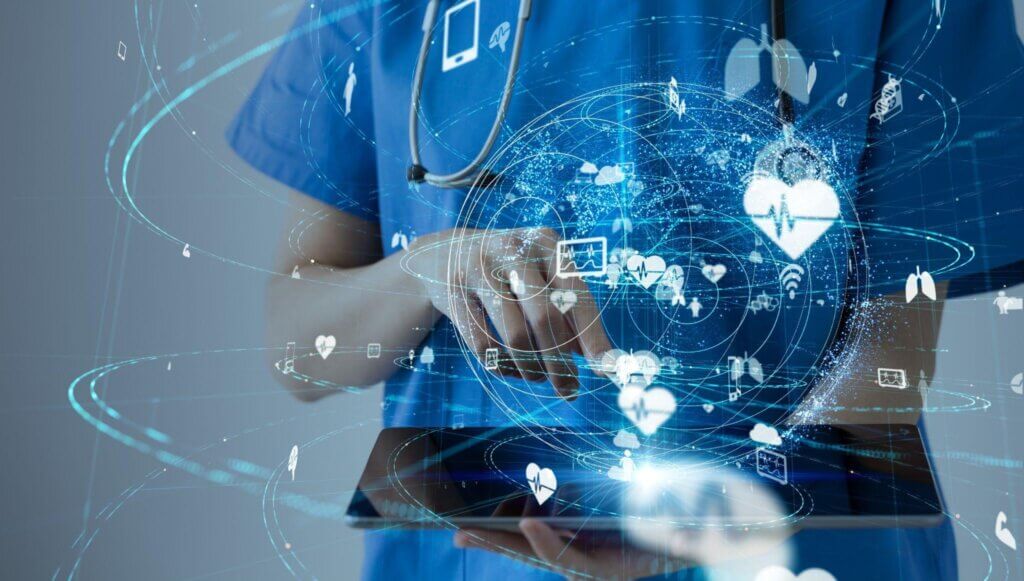Healthcare technology refers to the use of any software or IT tools to improve clinical and administrative productivity, obtain fresh insights into medical treatments and improve the overall quality of care delivered. Today, the healthcare industry is turning to technology to streamline processes and increase efficiency. The pressing need for better efficiency is made even more pertinent by the looming COVID-19 pandemic, which has brought unprecedented changes to the way that healthcare is delivered.
Here are the top eight healthcare tech trends to keep an eye on in 2021:
1. Telemedicine
Due to the COVID-19 pandemic, telemedicine’s popularity has increased significantly. Telemedicine refers to the use of technology to diagnose or treat patients from a remote location through live video conferences. Favoured by patients worldwide for their convenience, effectiveness and safety, the global telemedicine market is expected to reach USD 475.50 billion by 2026.
2. Internet of Medical Things (IoMT)
The Internet of Medical Things, or Healthcare IoT, comprises medical devices and applications that are connected to healthcare IT systems with the help of online computer networks. With the help of IoMT tools, health data can be collected, analysed and transmitted to healthcare provider networks. In turn, the data is used to improve patient care and streamline clinical workflow management.
3. AR/VR Integration
Augmented Reality (AR) and Virtual Reality (VR) technologies are increasingly adopted by medical professionals for various uses, such as educating patients before surgeries, improving training in medical school, assisting surgeons in planning interventions and helping patients better describe their symptoms.
4. Artificial Intelligence (AI) To Fight COVID-19
Unsurprisingly, Artificial Intelligence (AI) has been instrumental in the global fight against COVID-19. From dynamic, predictive heatmaps that identify areas at high risk of asymptomatic transmission, thermal screening to identify people with high temperatures to facial recognition technology that can identify individuals with masks, AI has played a crucial role in combatting the virus. Furthermore, AI has also helped to ease the strain on healthcare systems by obtaining unique insights into how the virus spreads and building a predictive model for better resource allocation.
5. AI & Automation
AI and automation have helped to relieve the clinical burden on healthcare professionals greatly, especially in the wake of the pandemic. For example, symptom-checking chatbots are used to assist diagnosis and ease administrative bottlenecks. With the constant evolution of AI, machine learning algorithms may soon be able to accurately detect heart disease and predict mental health trends.
6. Big Data Management
Big data analytics allow healthcare organisations to take the guesswork out of manpower allocation and improve overall patient care delivery. For example, time series analysis can be used to analyse past data and predict patient loads, improving resource allocation.
7. Blockchain
Blockchain is adopted in healthcare to protect patient data and improve the overall healthcare experience. Ensuring fast and secure transfers of patient and financial data have been a long-standing problem for many healthcare organisations, and blockchain technology has helped to resolve some of these issues.
8. Nanotechnology
Nanotechnology refers to science, engineering and technology conducted at the nanoscale, which is about 1 to 100 nanometers. Nanotechnology has been adopted in various medical applications, such as delivering vaccines via aerosols and patches and allowing more efficient diagnoses of diseases. Nanotechnology-enabled imaging and diagnostic tools have also improved the precision and efficiency of diagnoses, allowing for earlier treatment and better recovery outcomes.
Conclusion
In conclusion, advancements in technology have made it possible for the healthcare industry to adopt transformative products and services, improving delivery and quality of care. With the rapid development of technologies, we can look forward to more exciting advancements that will serve to shape the future of healthcare.

